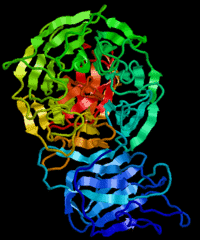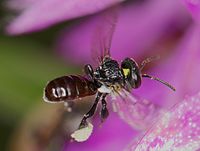
KCNT2-related disorders: phenotypes, functional and pharmacological properties.
Sign Up to like & getrecommendations! Published in 2023 at "Annals of neurology"
DOI: 10.1002/ana.26662
Abstract: OBJECTIVE Pathogenic variants in KCNT2 are rare causes of developmental epileptic encephalopathy (DEE). We herein describe the phenotypic and genetic features of patients with KCNT2-related DEE, and the in vitro functional and pharmacological properties of… read more here.
Keywords: properties kcnt2; pharmacological properties; kcnt2 related; functional pharmacological ... See more keywords

KEAP1‐NRF2 protein–protein interaction inhibitors: Design, pharmacological properties and therapeutic potential
Sign Up to like & getrecommendations! Published in 2022 at "Medicinal Research Reviews"
DOI: 10.1002/med.21925
Abstract: The transcription factor nuclear factor erythroid 2‐related factor 2 (NRF2) is considered the master regulator of the phase II antioxidant response. It controls a plethora of cytoprotective genes related to oxidative stress, inflammation, and protein… read more here.
Keywords: protein protein; protein interaction; keap1 nrf2; pharmacological properties ... See more keywords

p‐Synephrine, ephedrine, p‐octopamine and m‐synephrine: Comparative mechanistic, physiological and pharmacological properties
Sign Up to like & getrecommendations! Published in 2020 at "Phytotherapy Research"
DOI: 10.1002/ptr.6649
Abstract: Abstract Confusion and misunderstanding exist regarding the lack of cardiovascular and other adverse health effects of p‐synephrine and p‐octopamine relative to ephedrine and m‐synephrine (phenylephrine) which are known for their effects on the cardiovascular system.… read more here.
Keywords: synephrine ephedrine; physiological pharmacological; ephedrine synephrine; synephrine ... See more keywords

Pharmacological Properties of Faster-Acting Insulin Aspart
Sign Up to like & getrecommendations! Published in 2017 at "Current Diabetes Reports"
DOI: 10.1007/s11892-017-0931-y
Abstract: Purpose of ReviewFaster aspart is a new formulation of insulin aspart (IAsp) produced by adding the excipients niacinamide and L-arginine. As this new, “ultra-rapid insulin” is available in the EU-market and Canada, the pharmacokinetic and… read more here.
Keywords: insulin; pharmacological properties; insulin aspart; faster aspart ... See more keywords

Ethnobotanical, phytochemical, and pharmacological properties of Cerbera manghas L.
Sign Up to like & getrecommendations! Published in 2021 at "Journal of Biosciences"
DOI: 10.1007/s12038-021-00146-6
Abstract: In this review article, the ethnobotanical, phytochemical, and pharmacological properties of Cerbera manghas L. (Apocynaceae) are discussed. This plant has applications in traditional folk medicine as analgesic, anticonvulsant, a cardiotonic and for hypotensive activity. Phytoconstituents… read more here.
Keywords: cerbera manghas; plant; pharmacological properties; phytochemical pharmacological ... See more keywords

Fesoterodine: Pharmacological properties and clinical implications
Sign Up to like & getrecommendations! Published in 2018 at "European Journal of Pharmacology"
DOI: 10.1016/j.ejphar.2018.05.036
Abstract: Abstract Fesoterodine (as one of three drugs: dutasteride, finasteride and fesoterodine) was classified B (beneficial) by LUTS‐FORTA 2014, indicating that it is a medicinal product with proven or obvious efficacy in the elderly, with limited… read more here.
Keywords: properties clinical; methodology; fesoterodine pharmacological; clinical implications ... See more keywords

Pharmacological properties and mechanism insights of Moroccan anticancer medicinal plants: What are the next steps?
Sign Up to like & getrecommendations! Published in 2020 at "Industrial Crops and Products"
DOI: 10.1016/j.indcrop.2020.112198
Abstract: Abstract Moroccan flora is rich in medicinal plants that are widely used in traditional medicine for the treatment of various diseases including cancer. These plants have several bioactive molecules, which belong to secondary metabolites such… read more here.
Keywords: moroccan medicinal; pharmacological properties; mechanism insights; medicinal plants ... See more keywords

Genus Ruta: A natural source of high value products with biological and pharmacological properties.
Sign Up to like & getrecommendations! Published in 2020 at "Journal of ethnopharmacology"
DOI: 10.1016/j.jep.2020.113076
Abstract: ETHNOPHARMACOLOGICAL RELEVANCE Ruta genus is constituted by ten species, of which the most commonly described are R. chalepensis and R. graveolens. Ruta plants are perennial shrubs belonging to the family Rutaceae, which are traditionally used… read more here.
Keywords: ruta species; medicine; genus ruta; pharmacological properties ... See more keywords

A review of the ethnomedicinal uses, chemistry, and pharmacological properties of the genus Acanthus (Acanthaceae).
Sign Up to like & getrecommendations! Published in 2022 at "Journal of ethnopharmacology"
DOI: 10.1016/j.jep.2022.115271
Abstract: ETHNOPHARMACOLOGICAL RELEVANCE The Acanthus genus belongs to the Acanthaceae family, and its species are distributed in all continents, mainly in tropical and subtropical regions. Several traditional applications are referred to, but few scientific studies validate… read more here.
Keywords: anti inflammatory; acanthus species; pharmacological properties; ethnomedicinal uses ... See more keywords

Pharmacological properties of Salvia officinalis and its components
Sign Up to like & getrecommendations! Published in 2017 at "Journal of Traditional and Complementary Medicine"
DOI: 10.1016/j.jtcme.2016.12.014
Abstract: Salvia officinalis (Sage) is a plant in the family of Labiatae/Lamiaceae. It is native to Middle East and Mediterranean areas, but today has been naturalized throughout the world. In folk medicine, S. officinalis has been… read more here.
Keywords: medicine; properties salvia; plant; officinalis components ... See more keywords

The role of P2X4 receptor in neuropathic pain and its pharmacological properties.
Sign Up to like & getrecommendations! Published in 2020 at "Pharmacological research"
DOI: 10.1016/j.phrs.2020.104875
Abstract: Neuropathic pain (NPP) is a common symptom of most diseases in clinic, which seriously affects the mental health of patients and brings certain pain to patients. Due to its pathological mechanism is very complicated, and… read more here.
Keywords: pharmacological properties; neuropathic pain; receptor; role p2x4 ... See more keywords